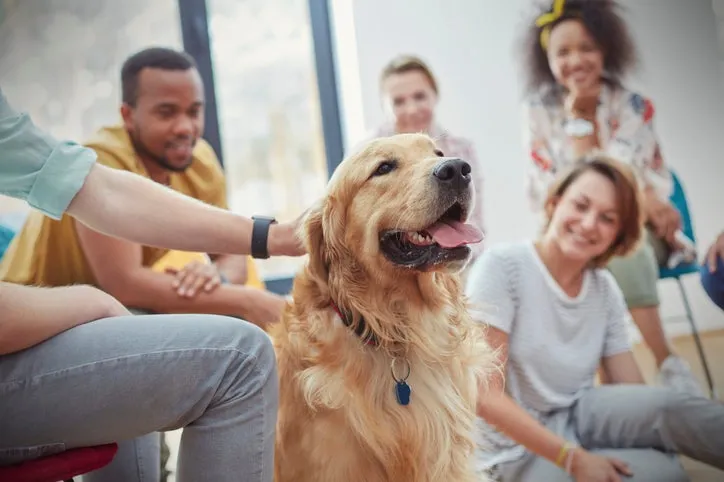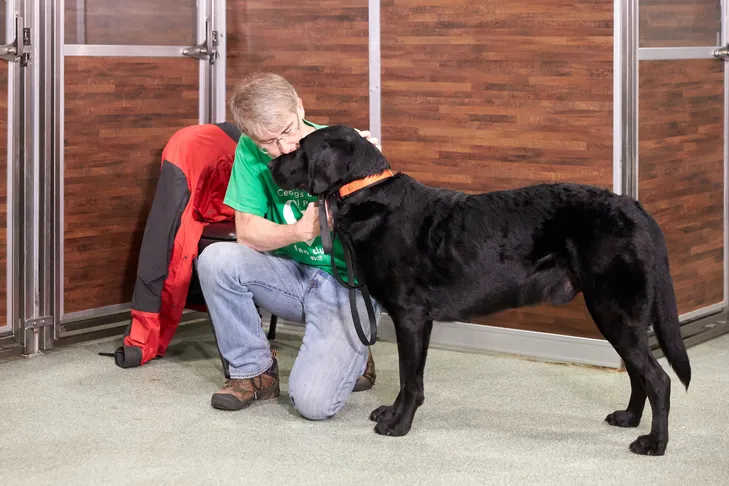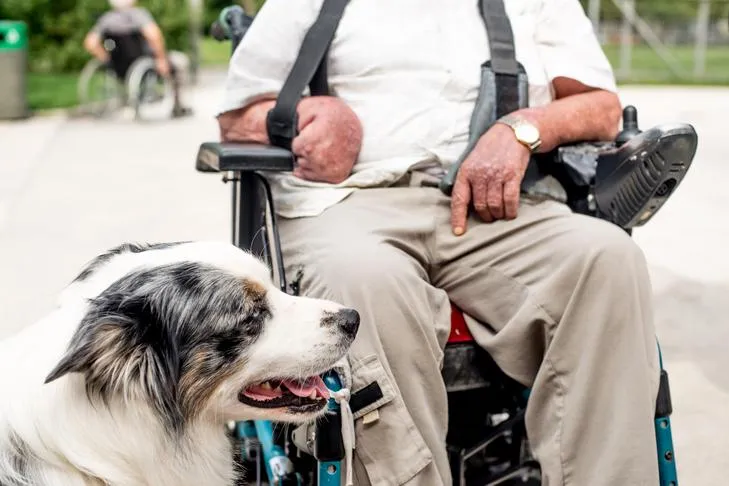In recent years, the profound health benefits of dogs have become increasingly recognized, leading to a surge in public interest in therapy dogs. These remarkable canines provide immense comfort and relief to individuals in various settings, from those facing anxiety-provoking situations to those experiencing grief, loneliness, or institutional stays in hospitals, nursing homes, and schools. Their gentle presence can make a significant difference in human well-being.
If you are a proud owner of a friendly, well-behaved dog that thrives on human interaction, you might be wondering about the path to becoming a therapy dog team. The journey to train your dog to be a therapy dog is rewarding, requiring dedication from both ends of the leash. Mastering basic obedience, such as ensuring your dog doesn’t train your dog to not pull on leash, is a crucial first step in preparing your canine companion for this special role.
Understanding the Role: What Exactly Is a Therapy Dog?
A therapy dog’s primary role is to offer comfort and affection to people, either in a facility setting or to individuals who require specific visitation to cope with physical or emotional challenges. It’s crucial to understand that therapy dogs are distinct from service dogs, who are trained to perform specific tasks for individuals with disabilities and are granted full public access under the Americans with Disabilities Act (ADA). They also differ from emotional support animals (ESAs), which require a prescription from a healthcare professional but do not need specialized training or certifications.
The Mutual Benefits of Therapy Dog Work
The positive impact of therapy dogs extends far beyond the individuals they visit. For humans, interactions with therapy dogs can lead to lower blood pressure and heart rate, reduced anxiety, and increased levels of feel-good hormones like endorphins and oxytocin. However, the benefits are not one-sided. Studies have indicated that therapy dogs themselves also experience higher levels of endorphins and oxytocin compared to average family pets, suggesting they derive pleasure and purpose from their work.
Linda Keehn, CPDT-KA, a therapy dog trainer, evaluator, handler, and owner of Positive Canine Training and Services in New York, emphasizes the diverse environments where therapy dogs can make a difference. “Therapy dogs go out to hospitals, nursing homes, libraries, schools, disasters. Essentially any venue where a clientele exists and it would be helpful for the dogs to be there,” she explains. However, becoming a therapy dog is not as simple as taking your dog to visit a relative in a hospital. Therapy dogs require certification from, and registration in, a reputable national organization. This certification is the culmination of a rigorous process that includes temperament assessment, training, and more.
Can Any Dog Become a Therapy Dog?
While your dog may offer unconditional love, that doesn’t automatically qualify them for therapy work. Similarly, an empathetic owner might not automatically be an ideal half of a therapy dog team. So, what are the key characteristics that make a good therapy dog, and how do you become a successful therapy dog team?
Most organizations require therapy dogs to be adults, typically not allowing puppies under one year old. Additionally, many organizations mandate that dogs pass the AKC Canine Good Citizen (CGC) test for obedience, while others may require a therapy-specific test. Keehn, who trains and evaluates dogs for both CGC and therapy certification, underscores the importance of these elements for any therapy dog in public. A dog that cannot master commands like “leave it” on cue or interact appropriately with children will likely not succeed. Basic obedience, including the ability to how to train recall in older dogs reliably, is fundamental.
Beyond these requirements, age and breed are generally not significant factors. Keehn has evaluated dogs ranging from a four-pound Yorkshire Terrier to a 13-year-old Beagle, both of whom excelled in their CGC tests. To ensure impartiality, Keehn only tests teams she has not personally trained. Aside from basic obedience, a therapy dog must possess a naturally social temperament, not be overly young or boisterous, and, crucially, must genuinely enjoy the “job.” As Keehn notes, “Most dogs love jobs. Your dog’s job may just be hiking alongside you, or something else. But most dogs like some kind of job and this is a wonderful job for them to have. However, it’s not fair to give a dog a job that it doesn’t want.”
 A handler gently guides a therapy dog on a leash, illustrating the close bond and teamwork required for therapy work.
A handler gently guides a therapy dog on a leash, illustrating the close bond and teamwork required for therapy work.
Is Your Dog a Good Candidate for Therapy Work?
To determine if your canine companion has the right disposition for therapy work, Keehn advises a dispassionate observation of your dog’s true temperament. The most important question to ask, she suggests, is whether your dog genuinely enjoys affection from people other than you.
“Does the dog really enjoy interacting with new people in different scenarios?” asks Keehn. “Does it seek out attention from people and have a calm demeanor? It could be the nicest dog in your living room, but not elsewhere. Most often in a therapy situation, people just want a dog that sits next to them and lets itself be pet.” In essence, ideal therapy dog candidates are inherently calm, friendly, and affectionate towards strangers. They are also proficient in basic obedience and can easily adapt to unfamiliar noises, places, smells, and equipment. Most therapy dog organizations also require dogs to be in good health, well-groomed, and up-to-date on regular health and wellness check-ups. Maintaining excellent house manners, a foundation laid by early training practices such as understanding puppy pad training vs outside, also contributes to a well-adjusted therapy dog candidate.
Are You Prepared to Be a Therapy Dog Handler?
Training a therapy dog is a journey that opens up new experiences for both the dog and the owner. As a team, you contribute positively to your community, and your dog’s world expands. Keehn recommends joining a national or local therapy chapter to foster social connections for both you and your dog. She underscores that therapy dog work is as beneficial for the handler as it is for the dog. However, handlers must be prepared to sometimes play roles beyond simply guiding their canine partner.
“Getting out of yourself and giving back to the community can improve your own mental and physical health,” Keehn asserts. “When you’re bringing a dog to a veterans’ organization or hospital, you may be the only non-medical person they’re seeing. It may be the only real conversation they’ve had for days. Be prepared as the therapy dog handler to connect to the client. It may be helpful to take a cognitive dog training course.” Additional valuable advice for handlers includes seeking mentorship from experienced handlers or consulting a reputable trainer for further guidance. At a minimum, most therapy dog organizations provide helpful printed materials or websites for preparation. Handlers also often have the flexibility to choose their work environment. If your dog loves children, visiting schools or libraries might be a perfect fit. Conversely, if you prefer not to work with children, home visits with the elderly could be a more suitable option.
 A golden retriever calmly sits with its handler during a therapy dog evaluation session, demonstrating good temperament.
A golden retriever calmly sits with its handler during a therapy dog evaluation session, demonstrating good temperament.
Step-by-Step: How to Train a Therapy Dog
When it comes to the actual training, you have the option to train your dog independently or seek professional assistance. Keehn, who helps owners train their dogs as part of a therapy team, advises seeking out formal organizations that list well-educated trainers on their websites.
If private training is not feasible, Keehn recommends studying the AKC CGC test, which covers ten basic commands, and then utilizing online resources like YouTube for training tips. Enrolling in a group Canine Good Citizen class is another excellent option, potentially followed by more directed and targeted classes. While these ten commands are essential for passing the CGC test, the ongoing training itself, especially when conducted with positive reinforcement, provides invaluable skills that last a lifetime. Mastering commands like how do i teach my dog to come is a cornerstone of this training.
“Every time you interact with your dog, your dog is learning something,” Keehn confirms. “Reinforce the behavior you want. Keep your criteria at a level that your dog can handle. Be clear in your communication with non-verbal and verbal cues. You don’t need to touch the dog. They learn to follow their basic instincts to sit and lay down by doing what’s comfortable.”
Essential Tips for Training Your Dog to Be a Therapy Dog
Embarking on the journey to train your dog to be a therapy dog is a significant undertaking, demanding considerable effort from both the dog and its handler. It’s a truth that some of the world’s most impeccably trained dogs may never be suitable for therapy work due to an incompatible temperament. Conversely, certain dogs that might initially seem challenging to train can flourish with the right approach and ultimately become exemplary therapy dogs. The comprehensive information above delves deeply into the nuances of therapy dog training. To distill it to its core principles, here are crucial tips to guide you as you begin this incredibly rewarding path:
- Prioritize Temperament: A calm, friendly, and affectionate disposition towards strangers is paramount. Your dog must genuinely enjoy interaction with diverse people in various environments.
- Master Basic Obedience: Solid obedience skills are non-negotiable. Commands like “sit,” “stay,” “down,” “come,” and “leave it” must be consistently reliable.
- Socialization is Key: Expose your dog to a wide range of sights, sounds, smells, people, and other animals from an early age to build confidence and adaptability.
- Positive Reinforcement: Always use positive, reward-based training methods. This builds a strong bond and makes learning enjoyable for your dog.
- Handler Preparation: Understand that you, as the handler, are an integral part of the team. Be prepared to engage with clients, offer empathetic support, and continually educate yourself.
- Seek Guidance: Don’t hesitate to consult reputable trainers, join therapy dog organizations, or find a mentor. Their experience can be invaluable.
- Health and Grooming: Ensure your dog is healthy, well-groomed, and up-to-date on all vaccinations and veterinary check-ups.
- Observe and Adapt: Continuously observe your dog’s reactions during training and interactions. Be flexible and adapt your approach to suit your dog’s comfort level and individual needs.
 An Australian Shepherd, a therapy dog, attentively sits beside its senior owner, offering comfort and companionship.
An Australian Shepherd, a therapy dog, attentively sits beside its senior owner, offering comfort and companionship.
Becoming a therapy dog team is a commitment that brings profound joy and purpose. By carefully assessing your dog’s temperament, diligently working on obedience and socialization, and preparing yourself for the unique responsibilities of a handler, you can embark on a journey that enriches not only your lives but also the lives of countless individuals in your community. If you believe your dog has the heart and spirit for this role, take the first steps today to explore the fulfilling world of therapy dog work.
